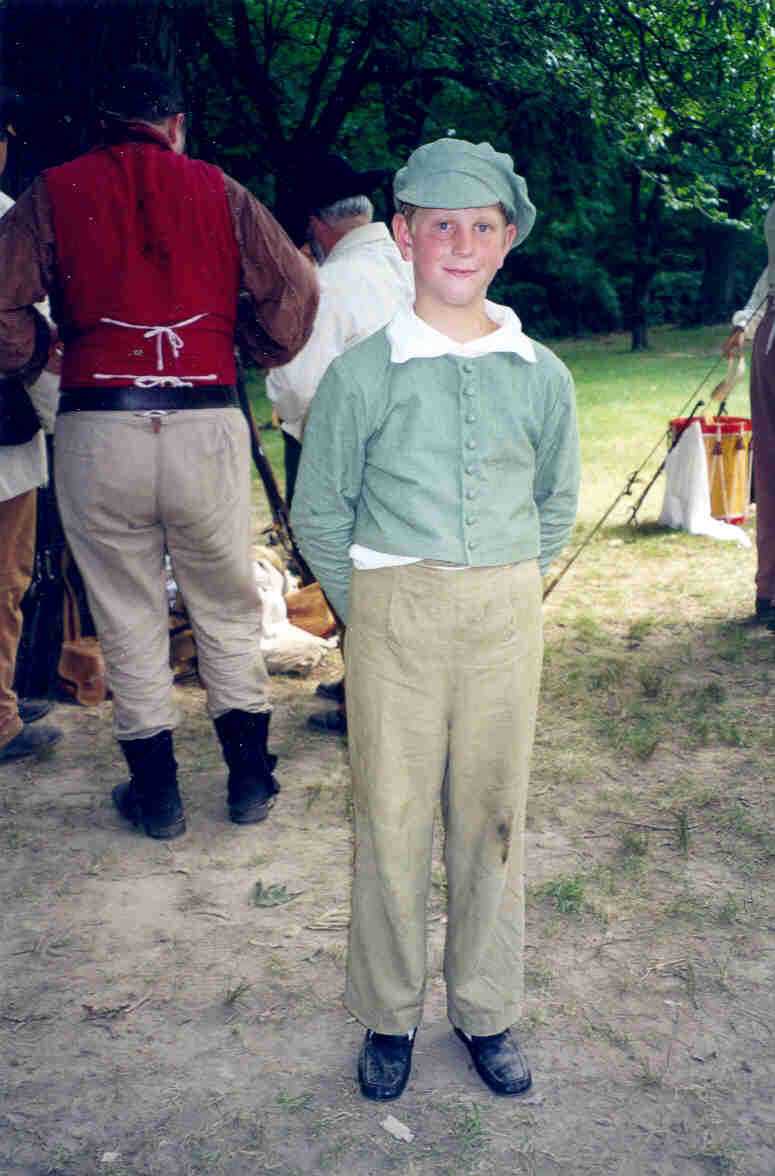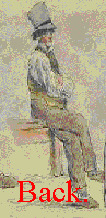Like women’s clothes of the time, boy's clothes were in a transitional stage. As in previous centuries, both boys and girls wore dresses of cotton and wool until about the age of six. Some boys wore their dresses over drawers of fabric that matched the dress allowing the drawers to show beneath the dress.
 At about the age of 5, boys would be "breeched" or put into long trousers. In the late eighteenth century, long trousers became the fashion for young boys, while adult men still clung to their knee breeches. In 1770, the "Skeleton Suit" became a popular fashion for boys from age five to ages eleven or twelve. The Skeleton suit was an innovation designed specifically for young boys-- not merely a scaled down version of adult clothes. The Skeleton suit remained popular for boys into the early 1830s. It consisted of high-waist trousers or pantaloons with a fall front and buttons, a short tight jacket, and a blouse with a deep collar. The jacket or vest could be buttoned to the trousers, creating a one-piece outfit for an active boy. On younger boys, the collar was sometimes frilled with ruffles while older boys generally wore plain collars. Blouses were long sleeved and sometimes worn without a jacket. White seems to have been the preferred color for blouses. A vest could be worn under the jacket and the jacket left open. The jacket and trousers were usually of the same color, although occasionally they were of contrasting colors. Red was a favorite color for Skeleton suits.
At about the age of 5, boys would be "breeched" or put into long trousers. In the late eighteenth century, long trousers became the fashion for young boys, while adult men still clung to their knee breeches. In 1770, the "Skeleton Suit" became a popular fashion for boys from age five to ages eleven or twelve. The Skeleton suit was an innovation designed specifically for young boys-- not merely a scaled down version of adult clothes. The Skeleton suit remained popular for boys into the early 1830s. It consisted of high-waist trousers or pantaloons with a fall front and buttons, a short tight jacket, and a blouse with a deep collar. The jacket or vest could be buttoned to the trousers, creating a one-piece outfit for an active boy. On younger boys, the collar was sometimes frilled with ruffles while older boys generally wore plain collars. Blouses were long sleeved and sometimes worn without a jacket. White seems to have been the preferred color for blouses. A vest could be worn under the jacket and the jacket left open. The jacket and trousers were usually of the same color, although occasionally they were of contrasting colors. Red was a favorite color for Skeleton suits.
Long tunics, some reaching the knees, offered another style option for younger boys in the 1830s. These were worn over trousers with a shirt featuring a wide collar appearing over the tunic neckline. The exaggerated "leg of mutton" sleeves of women’s dress appeared in boy’s clothes by the mid 1830s. Tunics or jackets with large "leg of mutton" sleeves were worn by boys over trousers cut very full from the hip to the knees then tapering narrow at the ankles. At the age of twelve, a boy’s basic wardrobe consisted of trousers with short jacket, white shirt and vest. As boys entered their teens they would begin to dress in adult fashions.
Footwear for boys follows that of women of the period. Indoors, and with the Skeleton Suit, boys often wore flat-soled, strap slippers or pumps of black leather. Ankle-high black boots known as "bootees" offered a sensible choice for outdoor wear. White stockings were worn by all.
As for headwear, caps with crowns of cloth became popular for boys during much of the eighteenth century. In many prints from 1801 to 1810, may bee seen a jockey cap with a round crown and cloth visor. From 1810 to 1819, cloth "wheel" caps with enameled leather visors became popular. By 1830, high hats (whihc gave every appearance of looking like a modern inverted flower pots) were worn by very fashionable boys.
Wool and linen were the most common fabrics early in the nineteenth century. These were fabrics that families could produce for their own use. Cottons were available but expensive. Before the Revolutionary War, cotton fabric had to be imported from Britain. The Crown did not permit Colonists to produce domestic cotton until after the war, when cotton plantations and manufacturing flourished. In 1804 in Philadelphia, calico was first printed using green dyes and fabric. By 1815, printing inks had improved. Machines for printing borders on fabrics were being used in 1825. New dyes to improve yellows, oranges, browns and better blues were available in 1827. By the 1830s there was a wide selection of fabric and colors for clothing. Favorites colors for boy's clothing included dull green, brown and black. Not unlike today, these colors tend to hide dirt.
In the late eighteenth and early nineteenth century boys finally had a style all their own with the Skeleton Suit. As they grew older, their style would mimic that of their father’s. These fashions were practical for young boys--allowing them full movement for activities associated with youth.
Sources:
McClellan, E. Historic Dress in America 1607 – 1870. New York: Arno Press, 1977.
Sichel, M. History of Children’s Costume. Philadelphia: Chelsea House Publishers, 1983.
Torton, P. Eubank, K.A Survey of Historic Costume. New York: Fairchild Publications, 1989.
Worrell, E. A. Children’s Costume in America 1607 – 1910. New York: Charles Scribner’s Sons, 1980.
Website: Historical Boy's Clothing.
